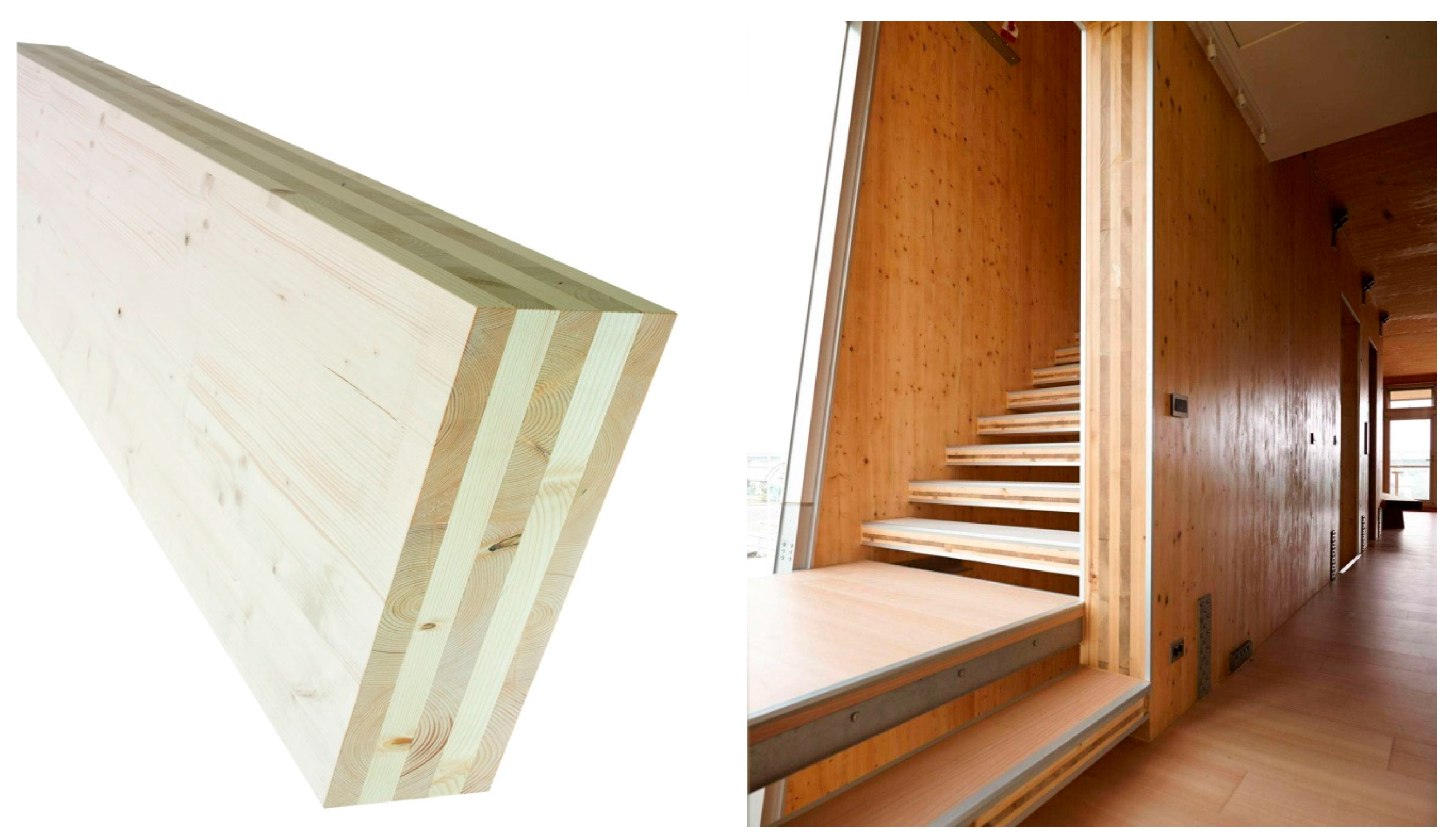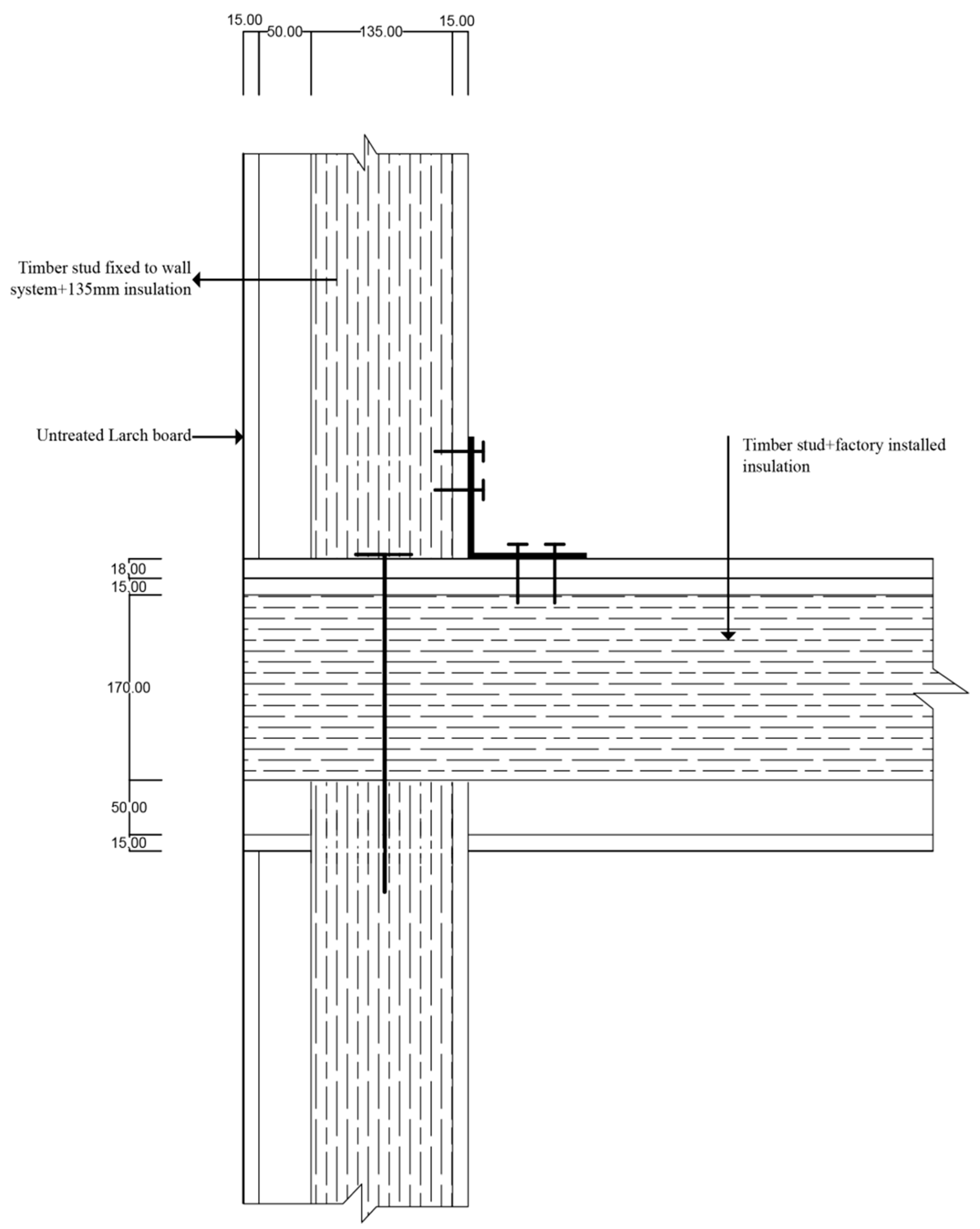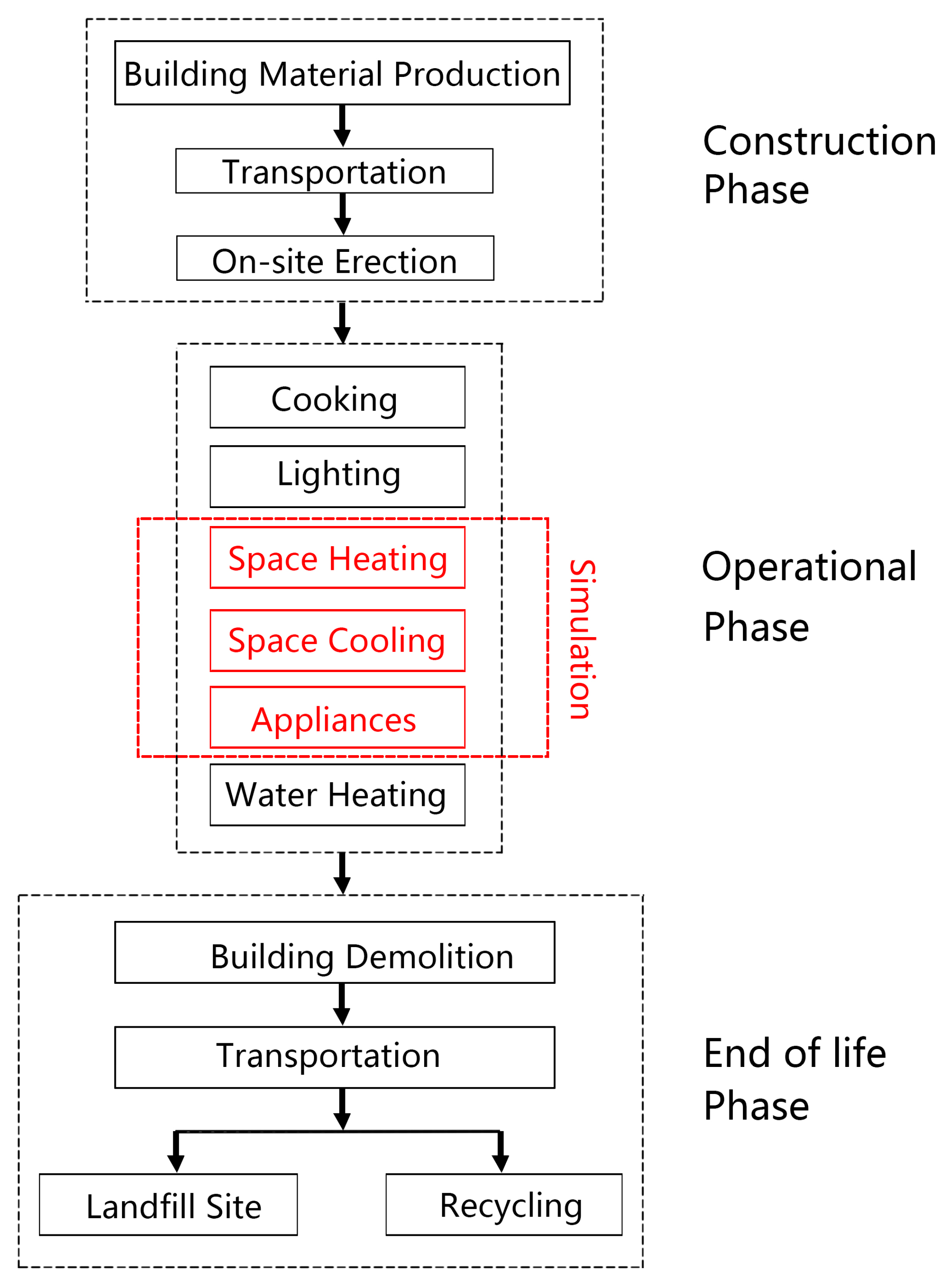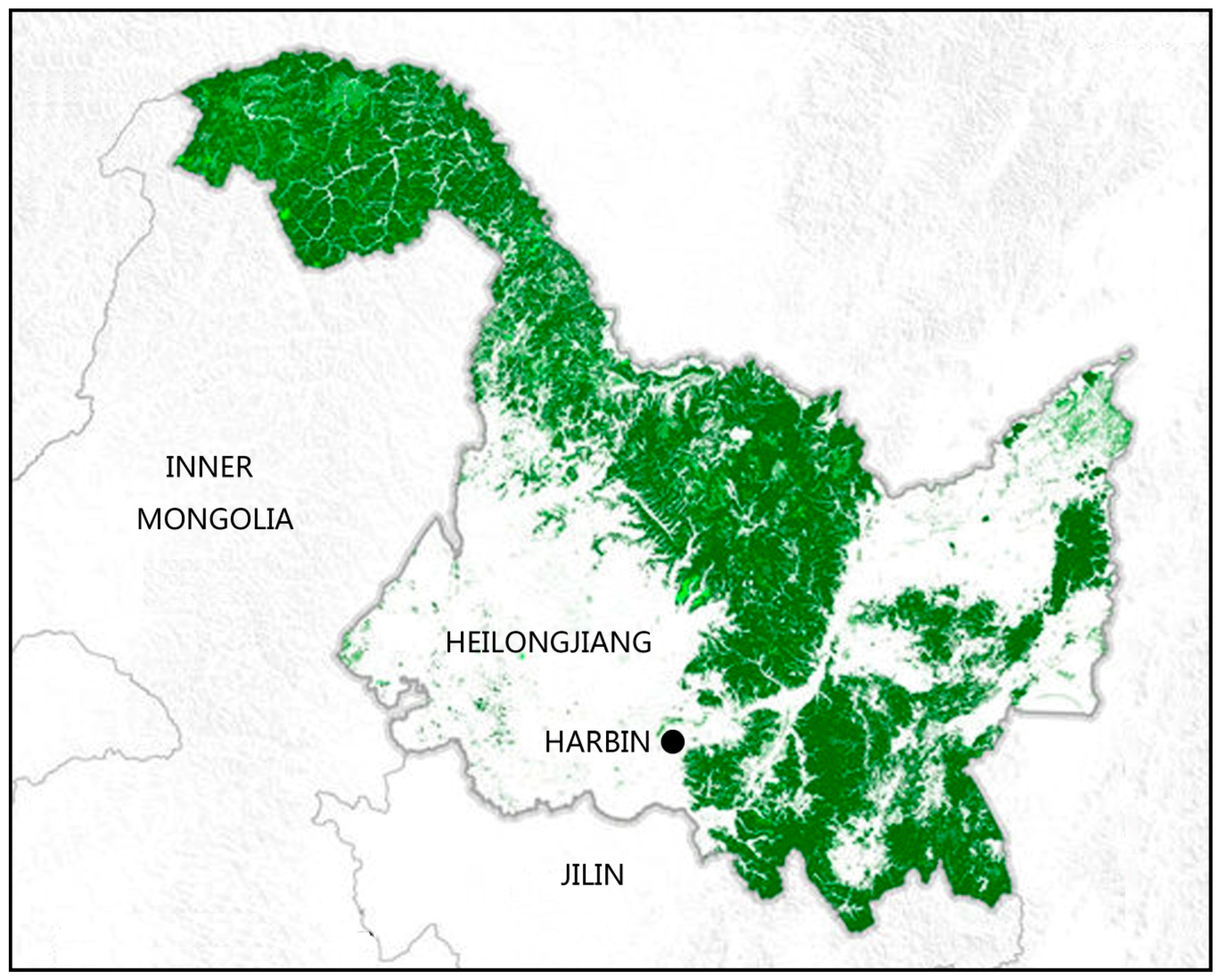1.1. Energy Consumption and Carbon Emissions in the Building Sector
At present, the construction industry is the most resource-intensive industrial sector in the global economy [
1]. The construction and occupation of buildings is a substantial contributor to global CO
2 emissions, with almost a quarter of total global CO
2 emissions attributable to energy use in buildings [
2]. The building sector is responsible for approximately 40% of the total energy consumption and carbon emissions in many developed countries [
3]. In Europe, the existing building stock is responsible for the consumption of 33% of raw materials and 50% of electricity generated, with residential buildings accounting for 16% of final energy use and commercial buildings accounting for 10% [
4]. In the United States, buildings account for 40% of energy use which is equivalent to 7.7% of global carbon emissions [
5]. In the UK, buildings account for 50% of total CO
2 emissions [
6]. In China, buildings also make a significant contribution to China’s total energy consumption, especially residential buildings. Eighteen percent of the overall Chinese greenhouse gas (GHG) emissions are from the building sector [
7]. In 2010, residential buildings accounted for 84% of total energy consumption by the building sector [
8]. Reducing the energy consumption and carbon emissions attributed to buildings is clearly an essential function of the government’s energy policy.
In China, there is no specific building energy data available from official sources. As a result, it is difficult to accurately assess the total amount of energy consumed by buildings in China. Some energy consumed by buildings may be counted more than once by different government sectors. Some references point out that the energy consumption per unit of floor area of buildings in China is much higher than that of developed countries [
9]. The IAE reported in 2007 that China’s building sector consumed 31% of China’s total final energy [
10]. The building sector was expected to be responsible for the consumption of 35% of China’s total primary energy supply (TPES) by 2020. China is undergoing a period of rapid development characterised by fast urbanisation. The Chinese government plans to increase urbanisation to 60% by 2030, and to 70% over the next 25 years. This means that 880 million people will be urban dwellers by 2030, requiring more residential buildings for this urbanisation [
11]. The construction of new buildings China amounts to a cumulative area of approximately two billion square metres annually, which accounts for nearly 50% of construction in the world [
12,
13]. It can be predicted that residential buildings in China will consume more energy and release more carbon emissions in the coming decades.
With development of new technology, new construction materials are increasingly more energy efficient and environmentally-friendly. The existing studies have shown that the energy performance of different building materials may vary significantly. Paolo et al. pointed out the relationship between different building materials by simulation. For the 40-story building, the embodied energy (EE) of the steel rigid frame with a steel–concrete floor is 43% greater than the EE of the RC frame with RC slabs, while for the 70-story building, the former is 88% greater than the latter [
14]. Treloar et al. compared the energy embodied in office buildings varying in height from three storeys to 52 storeys. The result showed that the high-rise buildings have approximately 60% more energy embodied per unit gross floor area (GFA) in their materials than the low-rise buildings. The 52-story building with a structure composed of a RC core and steel columns has an EE of 18.4 GJ/m
2 [
15].
1.2. CLT and Its Development in China
Timber is one of the most environmentally-friendly building materials available and has been used as a basic construction material for millennia. The adoption of new techniques and behaviour by a traditionally conservative industry has enabled continuous improvement in timber construction [
1]. New wood products, such as plywood, glue-laminated timber, and cross-laminated Timber, are frequently used as building materials in recent years. Plywood is a sheet material manufactured from thin layers of wood veneer that are glued together with adjacent layers having their wood grain rotated up to 90 degrees to one another. In China, this product is widely used as a non-structure building material for decoration. Glued laminated timber, also called glulam, is a type of structural engineered wood product comprising a number of layers of dimensioned lumber bonded together with durable, moisture-resistant structural adhesives. Among these wood products, cross-laminated timber (CLT) is one of the most recent innovations that have spread throughout Europe and worldwide. CLT construction technology originated from Europe in the early 1990s, and in the last two decades it has been used for a wide range of buildings worldwide, including single and multi-story residential buildings, office buildings, and other low-rise commercial buildings [
16]. CLT production rose from 25,000 m
3 in 1996 to 340,000 m
3 in 2010. In 2014, the global annual production of CLT was 600,000 cubic metres, and this is expected to reach 1,000,000 cubic metres by 2016 [
17]. CLT was introduced to the UK in 2001 and the material use is growing at a rate of 25% per annum [
1]. CLT based construction has also experienced rapid market growth more recently in the Australian, US, and Canadian markets. At present, the CLT production factories are mainly located in central Europe and these accounted for 80% of the global installed production capacity in 2015 [
18].
As shown in
Figure 1, cross-laminated timber (CLT) is an integrated building system which is constituted similarly to plywood, with boards that are glued side by side in a single layer and then glued to another layer of boards arranged crosswise to each other at an angle of 90° with the adjacent layers [
19]. Usually, CLT is composed of an uneven number of layers with at least three layers. Although CLT has been developed for 20 years, the product standard has only been introduced recently [
20]. As a result, the determinations of CLT panels vary significantly between producers. Different methods have been adopted for the basic mechanical properties of CLT [
21]. The thickness of a single layer is between 20 and 50 mm, and whole panels are available in thicknesses from 60 to 500 mm [
22]. The width and length of the panel are typically 4.8 m by 20 m. Due to its layered configuration, CLT possesses uniform mechanical and physical properties. The material can be used not only as load-bearing panels (walls, floors and roofs) and shear walls, but also for partitions and linear structural components in buildings [
23]. When CLT is used as a linear structural element, it shows promising resistance against shear in-plane and tension perpendicular to the grain [
24].
As a building material, timber has better energy saving and carbon reduction performance than other traditional building materials, such as bricks, RC, and steel. Although the energy and carbon emissions during the operational stages of a building constitute the majority of the energy and emissions over the building’s lifetime, there is also significant carbon emissions involved in the initial construction of a building. During construction, the extraction of materials, processing, manufacture, and transportation consume significant energy and have an environmental impact, which includes CO
2 emissions [
2]. When compared to wood framed buildings, RC-framed buildings consume approximately 80% more energy during the material production stages and release about 100–200% more net GHG emissions [
25]. However, wood may store approximately 1.10 tons of CO
2 per cubic metre. Even after wood harvesting, much of the carbon stored in forest products may not be released for decades [
26]. Gong et al. made a comparison between concrete and timber as materials for frameworks in Beijing in various scenarios, and showed that concrete frames consume 30% more energy than timber frames [
12]. During the operational phase, Guo et al. pointed out that, in China, the effects of energy saving and carbon reductions by CLT buildings show little relationship to the climate zone. On a national level, a seven-storey CLT building may result in a 29.4% energy saving, which is equivalent to a 24.6% carbon reduction, when compared with a concrete building in the operational stage [
17]. Liu et al. made comparisons between two seven-storey buildings constructed using RC and CLT in the severe cold region of China. They found that the energy consumption for heating and cooling was 338 MJ/m
2 and 231.2 MJ/m
2 per annum, respectively [
27].
The cost of CLT buildings may be a fundamental factor that affects the development and adoption of this material. The existing references indicate that the cost of CLT buildings is close to that of traditional building materials such as concrete, bricks, and steel [
28]. Currently, CLT is widely used for residential or commercial buildings between eight and 20 floors high, a range of buildings which is generally dominated by concrete and steel frame structural systems. Sellen showed that in the Pacific Northwest, the cost of a CLT design option can be as cost-effective as reinforced concrete. The costs of a 26 m high CLT building (eight storeys) and 38 m high CLT building (14 storeys) are approximately 32.5 US dollars and 31 US dollars per square foot, which is slightly higher than the cost of the same buildings in RC [
29]. Mahlum Architects et al. also indicated that the use of CLT as the construction material for a 10-storey building may result in a slightly lower cost than the concrete alternative (4%) [
28]. Pei et al. highlighted that equivalent or better performance than current code and existing concrete and steel structures is expected from tall CLT buildings. The cost of tall CLT buildings is comparable or less expensive than concrete and steel options in the US [
28]. Tall residential buildings are often believed to be high-energy consumers, mainly due to the large amount of materials required for the structure during construction [
14]. However, the total energy consumed by the building during its lifespan is not limited to the amount of material used, but also includes the energy consumed during the operational stage.
At present, reinforced concrete (RC) frames are the most frequently used structural material for buildings in China. Although the CLT system has not been well adopted and there are only a few demonstration projects for scientific research, there is growing interest in this material. The Chinese government also made a series of improvements to encourage the development of timber buildings. In 2017, the Ministry of Housing and Urban-Rural Development of China (MOHURD) revised the regulation of timber construction and published a new building code (GB/T 51226-2017). The new code extended the height of timber buildings to 56 m or no more than 18 storeys in non-seismic regions. It can be expected that the timber buildings in China will develop rapidly over the next few decades.
The aforementioned context has raised several questions. So far, limited references are available for the comparison of energy consumption between high-rise and low-rise residential buildings in China. Studies concerning the implementation of carbon emissions reductions by altering current carbon-intensive construction materials are scarce in China. Furthermore, the use of CLT in China is in its initial phase, and there is limited availability of studies of the energy saving performance of this sustainable material. This paper considers the energy consumption of residential buildings and addresses the following questions: (1) is using CLT as a sustainable material for construction an efficient way to lower energy consumption in China? (2) Do tall residential buildings have lower energy efficiency than low-rise and mid-rise buildings? (3) Do CLT buildings have a lower energy cost than RC buildings when performing a life-cycle assessment?










